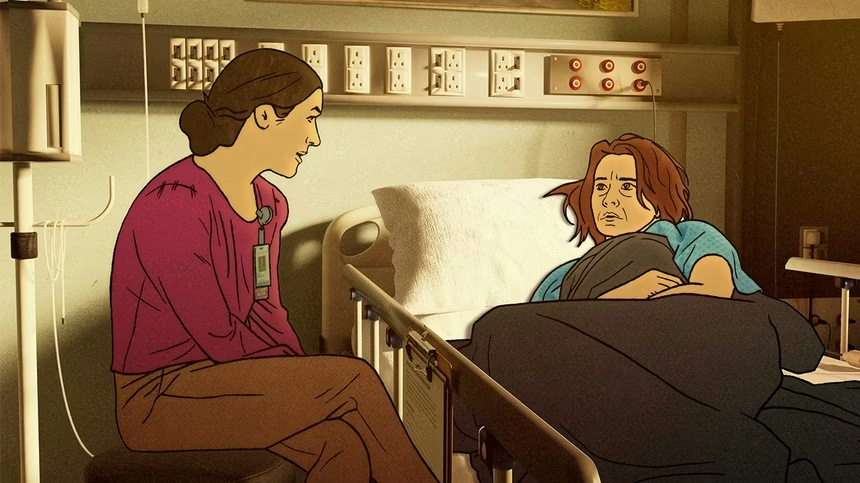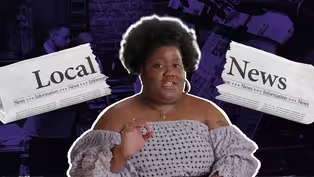
How Did This Women-Owned Newspaper Revolutionize Journalism?
Clip: Season 25 Episode 11 | 7m 8sVideo has Closed Captions
How a women-led newsroom blazed a trail for women's rights.
In 1850s America, one women-led newsroom blazed a trail for women's rights, shifting the media landscape and ultimately affecting how we see and cover "women's" issues today.
Problems playing video? | Closed Captioning Feedback
Problems playing video? | Closed Captioning Feedback

How Did This Women-Owned Newspaper Revolutionize Journalism?
Clip: Season 25 Episode 11 | 7m 8sVideo has Closed Captions
In 1850s America, one women-led newsroom blazed a trail for women's rights, shifting the media landscape and ultimately affecting how we see and cover "women's" issues today.
Problems playing video? | Closed Captioning Feedback
How to Watch Independent Lens
Independent Lens is available to stream on pbs.org and the free PBS App, available on iPhone, Apple TV, Android TV, Android smartphones, Amazon Fire TV, Amazon Fire Tablet, Roku, Samsung Smart TV, and Vizio.
Buy Now

The Misunderstood Pain Behind Addiction
An interview with filmmaker Joanna Rudnick about making the animated short PBS documentary 'Brother' about her brother and his journey with addiction.Providing Support for PBS.org
Learn Moreabout PBS online sponsorship- How did bloomers lead to a revolution for women in the newsroom?
Stick with me.
The fight for women and issues related to women to be front page news has been going on since the early days of this country, but The Lily, among the first publications by and for women, and started almost 175 years ago, changed all that.
So how did they do it?
(upbeat music) The Lily was established in 1849 by Amelia Bloomer.
If her last name reminds you of old-timey pants, that's because the term "bloomer" was coined because of her, but more on that later.
According to journalism historian Dr. Tracy Lucht, Amelia Bloomer was a temperance activist and abolitionist who made a lasting impact on women's rights in the US through discourse, dialogue, and practice.
Bloomer wasn't the first woman newspaper publisher and editor in the United States.
She had many predecessors and contemporaries, but she could be considered among the first to establish a newspaper by and for women.
Her work with The Lily is considered so impactful because she seamlessly combined women's rights with temperance activism, which argued that people should reduce or quit drinking.
This combination struck a chord with the newspaper's readership at a momentous time in history.
Bloomer linked the personal to the political, and unlike some female journalists of the time, she used her own name in print.
During the 19th century, reform movements flourished and focused on abolition, prison reform, women's rights, and temperance.
There were lots of local and often secret female-led societies that formed letter-writing campaigns to newspapers, hosted speaker series, and held conventions.
Okay, 19th-century women led secret societies isn't where I thought we'd end up in this episode, but I'm here for it.
The temperance movement drew mostly middle class and upper class white women, and Amelia Bloomer was no exception.
She agreed with the widely-held belief within that circle that women had a unique moral responsibility to take action for the temperance cause, but speaking publicly without anonymity was another matter.
In 1848, Bloomer and other members of a newly formed Ladies Temperance Society decided to create a publication to articulate their ideas publicly.
Until this time, Bloomer had written articles anonymously for local papers.
Eventually, the other women who proposed the newspaper project backed out, leaving Bloomer to forge ahead on her own.
So much for sisterhood and solidarity, right?
And, voila, The Lily was born.
Over time, the newspaper would grow and she would have many noteworthy contributors and supporters, including early women's rights activists Elizabeth Cady Stanton and Susan B. Anthony.
But let's take a look at what Amelia Bloomer is perhaps most famously known for, being the inspiration for the term "bloomers".
The Lily helped popularize these early pants for women, which are just giving, am I right?
Amelia Bloomer didn't invent this extremely stylish fit, but her paper helped to popularize the pants and make them a must-have.
In April 1851, Amelia decided to practice what she preached, announcing in that month's edition of The Lily she would wear the pantaloons both as a symbolic and practical step towards women's freedom.
The commotion over bloomers was met with equal, if not more, backlash.
Songs, caricatures, and plays helped construct the image of the bloomerite, a deviant woman who drank, smoked, joined the military, and abandoned her husband and kids.
Wearers of the bloomer faced street harassment, and a few even had relatives who forbid the clothing in their homes.
But there's that saying that any press is good press, and all this talk of bloomers grew the readership of The Lily from 500 to 4,000 people across the United States, making the women's issue paper more widely read than ever.
The Lily made a huge impact by linking the bitter humiliations of women's daily lives to their political disenfranchisement.
It printed various perspectives and included public letters that started conversations about gender roles and women's rights.
Bloomer also lived her values through the paper.
She hired women as typesetters, kept the price of a subscription low, and publicly supported other women editors.
But there were limitations to this publication, especially as it related to race.
Bloomer and her contemporaries often painted the struggles of other groups, namely Black and immigrant women, Black men and men of color, as subordinate or lesser than the causes of temperance or the rights of white women to vote.
Despite these ugly truths, Amelia Bloomer's writing arguably had lasting impacts by getting people to talk about women's rights and a woman's place in society.
Over the decades, women's representation in the media has evolved.
This includes things like the publication of Good Housekeeping, the relaunch of Cosmopolitan as a women's magazine, Ms. Magazine, and Bitch Magazine.
Additionally, independent print media, including feminist zine cultures of the '90s and websites in the 2000s, like Jezebel and Bustle, have pushed back at notions that women's issues are separate from other mainstream news.
And women today are definitely making strides in being both in front of and behind the pen and camera.
For example, in 2021, USA Today became one of the few mainstream newsrooms to be majority women.
Other mainstream outlets have been catching up.
Kimberly Godwin is president of ABC News.
She holds the distinction of being the first Black person and the first woman in that position.
Women leaders have also run CBS News, MSNBC, The Guardian, The Economist, The Financial Times, Politico, and the newsroom at NPR among others.
And The 19th, a women and LGBTQ+ led newsroom, was founded in 2020.
And yet issues with diversity in hiring, retention, and news coverage still remain.
In the United States, men still represent about 60% of newsroom employees.
A recent survey found that the news media is still one of the least diverse American workforces.
60% of news reporters and 75% of editors identified as white.
Nationally, Hispanic, Black, and Asian women make up less than 5% of traditional print and online newsrooms.
And fewer diverse perspectives means less coverage about important issues impacting marginalized groups.
As of 2021, only 24% of news coverage focused on women.
But hiring people with diverse experiences and identities might not be enough to change an entire work culture.
Other studies have pointed to factors outside of hiring and retention that can affect parity in coverage, like whether reporters are assigned certain types of stories based on identity rather than expertise.
Ultimately, this matters because journalism is a vital service that keeps us informed on important issues and conversations.
Whose stories become newsworthy and how people are portrayed directly impacts how the broader culture views and treats vulnerable communities.
Thanks for watching, and if you wanna see the story of how one women and LGBTQ-helmed newspaper is changing the face of journalism today, be sure to check out "Breaking The News" on the PBS app.
What are your favorite news publications?
Besides PBS, of course.
Let us know in the comments.
♪♪
Video has Closed Captions
Clip: S25 Ep11 | 9m 3s | What are the challenges facing local journalists? (9m 3s)
How Did Opinions Get In Our News?
Video has Closed Captions
Clip: S25 Ep11 | 7m 44s | It's not always easy to spot the difference between facts and opinion. (7m 44s)
Has Journalism Always Been This Stressful?
Video has Closed Captions
Clip: S25 Ep11 | 8m 52s | A mental health crisis has taken shape in our newsrooms. (8m 52s)
Video has Closed Captions
Preview: S25 Ep11 | 30s | Women and LGBTQ+ journalists launch news startup The 19th* to combat misinformation. (30s)
Providing Support for PBS.org
Learn Moreabout PBS online sponsorshipSupport for PBS provided by:




















